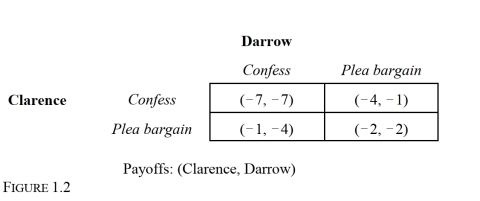Multiple Choice

-Consider the one-time, noncooperative, static game depicted in Figure 1.2. The Nash equilibrium strategy profile for this game is:
A) {Confess, Confess}.
B) {Confess, Plea bargain}.
C) {Plea bargain, Confess}.
D) {Plea bargain, Plea bargain}.
E) This game does not have a Nash equilibrium strategy profile.
Correct Answer:

Verified
Correct Answer:
Verified
Q23: A two-player, static game is one in
Q24: Which of the following assumptions about static
Q25: <img src="https://d2lvgg3v3hfg70.cloudfront.net/TBR1330/.jpg" alt=" -Consider the advertising
Q26: A Nash equilibrium:<br>A) Results in a payoff
Q27: A static game:<br>A) Is the same thing
Q29: The modern version of game theory can
Q30: Game theory attempts to explain:<br>A) Profit maximization.<br>B)
Q31: In a two-player, static game, players move:<br>A)
Q32: Simultaneous-move games are also called:<br>A) Noncooperative games.<br>B)
Q33: Games in which the players alternate moves